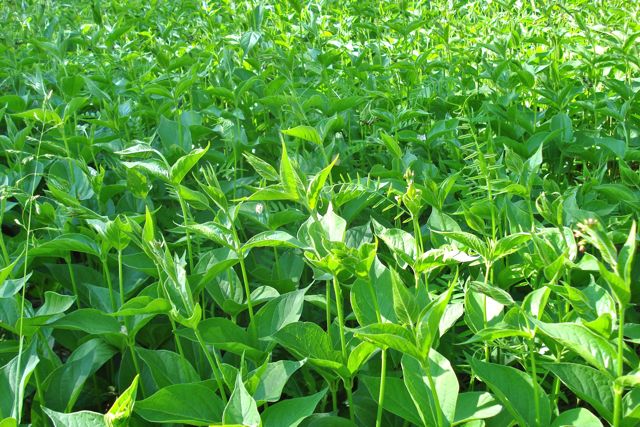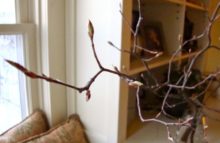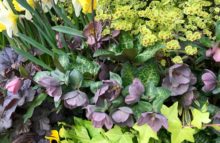Spotted during the Toronto Women’s Half Marathon in the Don Valley this morning (with my 15-year-old daughter; her first race) — masses, and masses, and masses, and masses of dog-strangling vine or swallowwort (Vincetoxicum rossicum, syn. Cynanchum spp., from the Greek meaning “to choke a dog”)
I’ve written warnings about this pernicious weed before: here and here. To see it taking over such huge expanses is scary.
This is a field of dog-strangling vine, almost as far as the eye can see. The next meadow over, it’s dog-strangling vine growing neck in strangly neck with garlic mustard. In another field, it’s wall-to-wall dame’s rocket (Hesperis) commonly called wild phlox. Somehow, this doesn’t seem as bad. However, as I read on another blog, WiseAcre Gardens, just this morning, dame’s rocket is also putting the squeeze on native plants.

Dog-strangling vine’s capable of lusty growth in sun or shade. It isn’t only open fields that are being over-run. It’s like the Badtimes virus warning, only unfunny: we should be very, very afraid.
UPDATE****If you have this plant in your garden, do not simply toss in your compost pile. Tougher measures are needed. More information about safe disposal of this non-native, invasive plant can be found here.
UPDATE*****Blog visitor Susan alerted us to a volunteer movement, Toronto’s Community Stewardship Program, whose aim is to adopt green spaces to help preserve natural species and fight green predators like this one. Toronto blogger Native Plant Girl wrote more about it in this post. And you can link to City of Toronto efforts and get involved at this site.
One of the upcoming events is this Saturday:
Saturday, June 6
East Don Parkland Wildflower Planting
Join us to plant wildflowers in a recently restored
wetland in the East Don River valley. Enter the trail at
Cummer Avenue and follow the signs south to the
planting site.
Partner: East Don Parkland Partners
For more info, call (416) 392- LEAF or email greentoronto@toronto.ca






9 comments
Never heard of it, but scared to death now!
“It will drink all your beer and leave its dirty socks on the coffee table when there’s company coming over.” – from the virus warning you linked to. DSV is almost at this point now.
But seriously, folks. I read this morning that even glyphosate/Roundup (now banned in Ontario) doesn’t even fully eradicate this stuff.
Gardeners at a nature garden near Ottawa tried several techniques that worked for them fairly well to stop the spread, and kill infestations:
1.Heavy rototilling, and immediately handpicking and discarding the roots. Then quickly planting native species + shrubs that would compete. This would take an army of thousands in the Don Valley.
2. Mowing very low, before flowering. Then smothering with tarp, heavy, heavy mulch or plastic. Leave in place for a season, then heavily plant with native species.
All these techniques require on-going maintenance and monitoring of course.
Have not found yet how this plant took such a foothold in recent years. Is is even worse than the garlic mustard? I think it is, because the stems are so woody, and when they are cut, two more grow in its place.
Scary stuff. I battle garlic mustard all the time, but I haven’t encountered this at my place. Sure hope I don’t.
The community stewards of Toronto, a small band of volunteers broken into teams and working at 11 “stewardship” sites or ravines, are working to halt the spread of these invasives, but it seems a case of too little, too late.
On my own street in downtown Toronto I now see many properties with garlic mustard peopling the front lawns.
It looks benign. The city probably needs to launch a PSA campaign. Most people don’t know about it.
Thanks, Susan, I’ve added an update to the blog. Failing a PSA for now, all we can do is keep writing about it. There are fact-sheets available, but you have to know where to look.
I grew up in the Hamilton area and never saw this weed until this summer, when I moved to Toronto for a summer landscaping job…it's incredible how invasive it's become.
Roundup will kill it but not at the 5% mix us mortals can buy (probably need to crank it up to small-tree-strength), but repeated applications will work. It may be legal to use it on this plant as it's an invasive species—it's legal to use it on poison ivy, for instance. Actually, glyphosate isn't that toxic; Killex stays around in the soil and has a lower LD50…maybe that'd work (if it was legal).
Nick, On some of these massive infestations, large-scale application of any herbicide would be difficult.
Sarah's suggestion of mowing before flowering and smothering is probably the best bet. In a small garden, get out a sharp knife and cut off any stems just below soil level. Keep cutting off any resurgent stems till the root stops sending them up.
These spread because they are used as ornamental plants, I noticed they were especially prominent in rosedale backyards, which is upsetting on so many levels.
I doubt that they're consciously used as ornamental plants, but they do sneak into cultivated gardens through airborne seeds, and people don't recognize them as invaders. I've seen them in local gardens, too, and often resort to "random acts of gardening" whenever they're in reach. At the very least, I cut off the flowers. I also rant about them to whomever will listen.